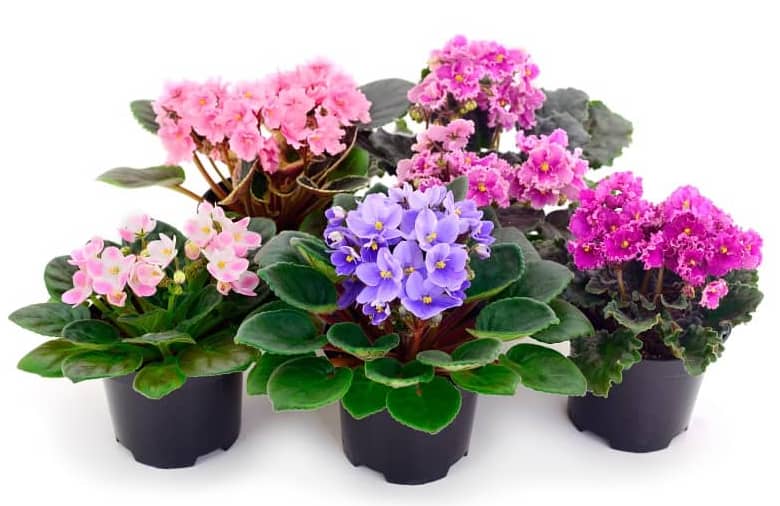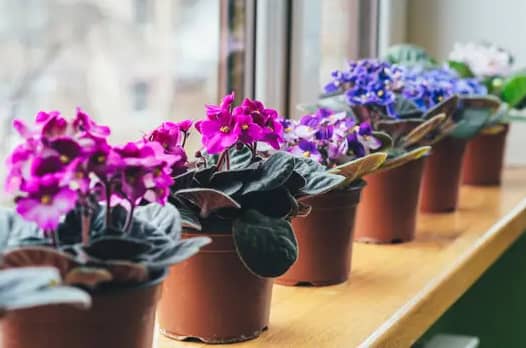African violet care is quite easy. After understanding their basic growing needs it’s easy to answer how to take care of African violet plants indoors.
For your plants a mix of peat moss, perlite, and vermiculite is ideal. Place your plant in indirect sunlight or use medium fluorescent light, maintain temperatures, and supply at least a perfect amount of humidity. Weekly watering and fertilizing once per month. That’s all! What are the basic tips on how to take care of African violet plants indoors.

Their wonderfully shaped crimpy leaves, compact form, and bright, beautiful blooms will attract you to care for them. African Violets have the kind of charm to cheer up the indoor environment and make you smile. Isn’t it? If you are new to growing African violets at home or just want to learn more about how to take care of African violet plants indoors. This article is penned for you. Here are some reliable tips, to keep your African violets healthy and flourishing.
Low-maintenance African Violet Care:

However, the low-maintenance house plant African Violet’s basic care starts with the potting.
African violet potting
Well-drained potting
For your African violet, well-drained potting is very much essential. It will provide better air circulation for plant roots and good moisture retention. Poor drainage can cause root rot as well.
Prevent waterlogging
After waterlogging, it’s possible that African violet leaves begin to fall. So you should make sure that the plant is never allowed to be exposed to standing water for a long period of time.
Potting mix
African violets mandate a light, slightly acidic, porous, potting mix. There are commercially available potting mixes made particularly for African violets, that’s pH levels around 6.8. But sometimes people prefer to mix their own. If you choose to do so, you can try a 1:1:1 blend of sphagnum peat moss, perlite, and vermiculite.
Soil test kit
Make sure to have a soil test kit for optimal results. Sometimes, the saleable African violet potting mixes can be too packed and hold too much moisture. In such a situation, you can fix it by testing and mixing a general-purpose organic potting medium in a 1:1 ratio.
Water – Best Ways to Water African Violets
For African violets need moderate watering to avoid root rot. Do indoor plants like watery ground? Absolutely not, it’s important to keep the soil moist but not watery. Ensure water to your plants only when the soil surface is dry to the touch. For example, take a toothpick or use your finger to put it on the soil. If there are only the tiniest soil particles that stick to your finger or toothpick, that means the soil is dry enough.
- Maintain soil moist with warm water and seek high humidity.
- Do not allow water to reach the leaves to prevent damage, other than light misting.
- Water from below, or drive the water tap into the soil when watering.
- Don’t let the plant sit in wetness.
- Control the watering close to the soil to avoid aloft watering as it may cause leaf spotting.
During the blooming season, the plant likes to be a little dry but not to the point of wilting. Remember to monitor and attend to what your plant needs. If the African violet leaves start to droop and the soil is dehydrated, apply some water. Do not put too much water in a shot to revive the plant as it may cause stress and stunner.
Temperature and Humidity for African violets care
These need high humidity and plenty of gentle misting for flower well and healthy growth. You can use a humidity tray to keep the proper levels. At the bottom, it needs to have small stones or a layer of gravel with added water.
- Compartment temperatures of around 65°f / 16°c — 75°f / 24°c are models.
- Lower than 60°f / 15.5°c temperatures don’t allow to decrease.
- And avoid cold wafts or harsh temperature changes.
In order to flower is African violets need above 70 degrees indoor temperatures? Honestly, the answer is no. Maximum African violets blossom in temperatures that range from 55 to 65 degrees. Only when the morning sun heats the glass you can keep your plants in a window. And return the planets away from windows on bitter nights.
To increase humidity
- First set plants together.
- Then placed on pebble-filled trays.
- Use galvanized “boot trays” for work nicely.
- And you can paint them to fit with your window border or looks classy.
- Now refill the trays with water.
- Currently, make sure your plants are relaxing above the water level and on the pebbles.
While plants are watered from the top, extra moisture drains down into the pebbles. And it produces moist air as vaporizes. Oversize saucers or pebble-filled bowls are convenient alternatives to the trays. In a low humidity atmosphere, most of the African violet species such as Saintpaulias will not bloom. In about 50% relative humidity they revel. It is fairly high for the average indoor conditions in winter.
If you suffer from an itchy throat and dry skin, the furnace roar. Then just guess how unfortunate your African violets must be. It’s more pleasing to grow the plants in clay pots for proper temperature, healthy roots, and humidity. Because clay naturally soaks moisture and then emits it as humidity through evaporation.
African violet fertilizer
Plants don’t take fertilizer as medicine. African violet fertilizer is prepared for healthy plants using up ground nutrients. Furthermore, growing plants require the correct amounts of energy from the sun, and nutrients from the soil, water, and carbon dioxide. Over-fertilizing truthfully produces sick plants, helpless to disease, cold weather injury, and death.
How Fertilizer Kills
When it comes to over-fertilizing salt is the direct villain for plants, as Texas A&M Extension. It is deadly to plants. Saltish plants can’t soak water adequately. To adjust salts plants use up a lot of energy that would otherwise be spent for growth. In addition, those plants also attract pests like aphids, who love delicate leaves. Result pests literally suck the life out of plants.
Signs of Over Fertilization
Signs of over-fertilization contain
- Yellowish or dull green leaves.
- Smaller than usual African violet leaves.
- Scarcity of leaves, dead branches, and wilted leafage.
- Annual growth of short twigs.
- And plants that need excessive trim.
Unfortunately, once plants start to show these signs, there is no treatment. Greg Stack, Horticulture Educator at the University of Illinois Extension suggests if over-fertilization is caught instantly, it’s possible to use extreme amounts of water to wash away the fertilizer.
Correct Fertilization
The North Carolina State University Extension Service guides before fertilizing, waiting six to eight weeks for newly seated plants. For best results, apply African violet fertilizer lightly. For example, use 1 tsp. of 10-10-10 fertilizer for every gallon container.
The Right Light
In sunny or indirect light best African violets grow perfectly and blossom. If somehow your African violet has quit flowering, pay notice to the lighting in your room. Ensure sufficient natural sunlight, but avoid direct sunlight. You can use medium LED or fluorescent lights for African violet growth too. Nearest, your south- or west-facing window’s sun’s direct rays can diffuse through a classic stylish sheer curtain.
African violet propagation
Naturally, propagating African violets is executed by leaf-petiole cuttings. During potting, you can increase the number of your plants by dividing, directly from seeds, or via suckers.
When comparing the time required to get a full-fledged plant, between the different methods of African violet propagation division is the best way to go. In this method, the mother plant is separated from the existing plantlets. This is the fastest and easiest way because new plants already have roots. Normally, it will take 12 weeks for the cuttings to get strong and healthy enough to be propagating.
On the other hand, in the second term come topics about leaf cuttings. The leaf cuttings application will help promote root development faster by rooting hormones. Among all these methods, don’t forget to prepare the right African violet soil mixture. choose a premade growing mix of soil that is loose and has good drainage. Thus having the right soil root rot can be avoidable.
Repotting African Violets
When plants feel unwell that’s the best time to repot and transplant African violets. Generally, Saintpaulia prefers to be root bound so repotting should be done only when they outgrew their pot. Although, as a general rule, it should be transplanted or repotted twice a year. Doing this, it will allow the plant to grow and flourish.
Saintpaulia’s roots do not like to be bound. So when they leave their pots, repotting should be done. As a general rule, it should be transplanted or replaced twice a year, even if it does not seem necessary. As a result, the growth and development of the plant are accelerated.
When repotting African violets
- Select pots slightly larger than before and remove excess soil leaving only the part attached to the roots.
- Transfer the African violet to a large container and add soil around the base of the plant, which is called soft replacement.
Potential Pests and Diseases
The African violet contains 2 common insects. One of them is the cyclamen mite and the other is the mealybug. Both of them were sucking insects and they struck the leaves. These are most often found under the cracks of the plants. Insecticidal soap can be an instant solution for mold infections.
On the contrary, the African violet often has fungal diseases, such as botrytis blight and root and crown rot. Fungal diseases have no known cure. Yet It is best prevented with the use of protective fungicides and eradication of infected plants or plant parts.
In addition, insects and pathogens can cause African violets problems. For example, salt accumulation in the trims of a pot can cause rot. Flushing with plenty of water will solve this. Another common problem is the formation of water stains due to the drying of water droplets on the texture of the leaves. This problem is more common during cold weather.
Helping your African violets bloom
Let’s discuss the most practical multiple tips and tricks, to keep African violets most blossoming plants.
Keep It Happy
The best way to keep them healthy is to keep them happy. Naturally, to keep your indoor African violet happy,
- You need to choose terracotta.
- Keep it at the right temperature. The most important thing is to be careful about watering.
Give It Nutrients
Are you taking proper care of African violets? Is it still not blooming enough to your liking? Then ensure proper nutrition to keep African violets healthy.
Provide Enough Light
Dying to get enough light, African violets cannot bloom. They can be positioned near a west- or south-facing windows or placed outside for a period in the morning. Another way is to install grow lights.
Increase Humidity
To ensure that your flowers bloom well, you need to ensure an environment full of enough moisture for them.
They want more than 50% humidity. They need to be kept in trays and moistened frequently when full moisture is available, which is a great way to increase humidity. You can also keep a humidifier, such as the Dis Extra-Kite model.
Give It a Trim
Another common way to help your African purple flowers bloom is by trimming and tanning. When the top and sides of the tree are covered by new growth, trim it.
Keep It Protected From Pests
Did you know that pests and bacteria are harmful to African violets? Yeah, it prevents flowers from blooming and blooming for a long time. An underrated way is to protect it from pests and bacteria.
Are you thinking of using Artificial or Chemical? We would suggest the best way to do this is to use organic pest control methods (such as spraying with organic neem oil or turmeric) or high-rated plant-friendly pesticides.
In accumulation, maintaining the happiness of your plant and the right environment helps decrease the risk of disease, bacteria, and bugs.
How to trim an African violet from a dead blossom
Step 1
Check your African violet. Is there any sign of dead, dying, and unhealthy blooms? They will have vital energy away from the plant’s ability. Don’t allow them to remain on the plant, and be irritant while producing new blooms.
Step 2
Hold dead, dead, or unhealthy flowers with one hand. Cut it with scissors slightly forward just behind the dead or dead tissue. If left untreated, it will help the disease or fungus to reproduce.
Step 3
Take some time to observe your African violet. You can check every few days or after a week. Remove dead, dead, or unhealthy blooms during the blooming period as soon as possible to keep your plant in amazing condition.
Safety Considerations
African violets are one of the safest house plants considering toxicity. Without any kind of poison, they are an excellent choice for children or pets.
- Use room-temperature water which is slightly warmer.
- Bottom watering is easier because of spreading leaves.
- Repeatedly watering is sufficient to keep the soil moist, but not flooded.
- Pollen can be an issue for allergy sufferers. However, they should be warned about that.
- Dust or other allergen particles can become their lover also.
Watch Now: How to Grow and African violet care.
Types of violet for you
Currently, there are more than 16,000 species of African violet, and the number continues to grow. In general, the African Violet Society of America has divided these species into the following major species:
One of the unique ones is Saintpaulia, which is unique due to its different shapes, leaves, flower characteristics, and flower color. These large standard African violets grow in a low, compact rosette of leaves layered on a small stem with a bunch of flowers in the middle. They can grow from 8 inches to about 24 inches (larger value).
Another variety, Seminicar Violet, is less than 8 inches in diameter. In the end, the tiny African violets grow to about 6 inches. This small African violet would be a great choice for displaying in the cramped space of an indoor environment.
After natural violet, hybridizers create cultivars based on different varieties and other characteristics. These include variegated leaves, which may have some amount of white or pink on the leaves, usually surrounded by white-green and enhance the color. Types of violet flowers include white-blue-red multiple colors as well as semi-dual and multiple different color ranges of flower petals.
Leaf types of violet offer another element of ornamental value as well, with at least 11 different shape categories in existence, including girl-shaped, holly-shaped, ruffled-edge, longifolia-shaped, heart-shaped, ovate, pointed, round, scalloped-edge, serrated-edge, and spoon-shaped leaves.
African Violet Characteristics
African violets normally raise 2 from 6 inches tall. Furthermore, depending on their variety, the range can start from about 3 inches to over a foot. Just above the leafage most of the African violets depict flower clusters at the center.
Some cultivars’ foliage is covered by rosette-like layers of dark green leaves. And their characteristic blooms come with semi-double or double coatings of petals, bicolored flowers, faster growth habits, or small sizes.
As Candy dandy (peculiar names of variety) well-maintained plants can flower almost continuously. A huge amount of diverse African violet color mixtures for petals, from pink-colored Rococo pink to multi-colored double-flowered, will grab your attention. Those petals also have different shapes, edges, and amounts which represent their attractiveness.
The most specific characteristic of African violets is their murky, succulent greenery than their blooms. The fine hairs on the African violet leaves help the plant absorb water from the air as well as for adaptation. Some variegated leaves from the cultivar also contain a ruffled appearance and add ornamental value. There are also various leaf varieties of African violet. The boy, girl, variegated (green and white), spoon, holly, serrated, and lance-shaped are included as their names depending on their engaging shapes.
Crimson Icefall in the likes for its incredible crimson red flowers and undemanding nature of every houseplant lover. In your room or office, It will add a magical touch perfectly and will adjust in low light. We will suggest summer twilight. Which is one of the most popular African violet adored for their unique appearance. The aroma of Summer or Summer Twilight features majestic red and lilac-purple flowers with a white border.
If you want unique and bored with purple African violets, then have Zephyr. It’s an incredible and classic pretty flowering variety with soft pink at the center and white at the border. flowers.Cherry Princess. Then the Julia, Myakka Trail, Cherry Princess, and Little Maya look fabulous with their elegant color which you can adapt easily.
FAQs About African Violet Care
Are African Violets toxic for children and pets?
African violets are not toxic for your kids and pets. If you remain close to them, they won’t be poisonous to touch. Even non-toxic if eaten by your children and the majority of pets.
What conditions do African violets like?
African violets will blossom in a bright, friendly, and humid environment. African violets like clean conditions, so as possible as you should remove dead flowers and leaves. It will encourage a healthier state for them too.
How long do African violets last?
African violets can last for 50 years. Truly, the Bay State African Violet Society claims an African violet (Saintpaulia spp.) can last indefinitely. With proper care, it’s normal for them to live 50 years or more. But to ensure proper African violet care you have to avoid overwatering, cooling, and direct sunlight. These three common things can drastically lower an African violet’s lifespan.
Can African violets survive snow?
Too cold temperatures are harmful to African Violets. So, while it’s about snow, African Violets will suffer. In more severe cases, they stop flowering, even plant growth becomes slow. Leaves and flowers can begin to fade away, and at the very least the plant will go into impact terribly.
Final words for your adaptable and colorful African violets
Now we’ve talked about the ins and out of how to care for African violets, you may already concede. African violet care isn’t nearly as hard to take for. So, best of luck on your next journey with your lovely African violets.






